Summary
The application of engineering principles is explored in the creation of mobiles. As students create their own mobiles, they take into consideration the forces of gravity and convection air currents. They learn how an understanding of balancing forces is important in both art and engineering design.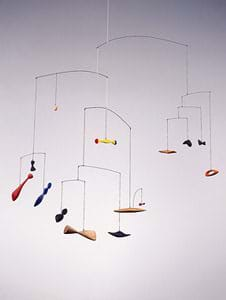
Engineering Connection
When creating a mobile, Alexander Calder balanced all the forces created by the hanging objects. In the construction of buildings or bridges, engineers also balance forces. They make sure their design can support the anticipated forces caused by people, hot tubs, nature, cars, etc. So, they add up all the potential forces that could be applied to a structure and compare that to the amount of force their design can hold. This is similar to what artists do, but instead of balancing the forces to make sure a mobile can hold the weight and look intriguing, engineers balance the forces to create safe form and structure for people to use.
Learning Objectives
After this activity, students should be able to:
- Understand that engineers and artists use the same concepts of forces to create a design.
- Understand the relationship between forces and mobiles.
- Experiment with materials, tools, techniques and processes that enhance communication of ideas through art.
- Practice using numbers to describe balanced forces in example math problems.
Educational Standards
Each TeachEngineering lesson or activity is correlated to one or more K-12 science,
technology, engineering or math (STEM) educational standards.
All 100,000+ K-12 STEM standards covered in TeachEngineering are collected, maintained and packaged by the Achievement Standards Network (ASN),
a project of D2L (www.achievementstandards.org).
In the ASN, standards are hierarchically structured: first by source; e.g., by state; within source by type; e.g., science or mathematics;
within type by subtype, then by grade, etc.
Each TeachEngineering lesson or activity is correlated to one or more K-12 science, technology, engineering or math (STEM) educational standards.
All 100,000+ K-12 STEM standards covered in TeachEngineering are collected, maintained and packaged by the Achievement Standards Network (ASN), a project of D2L (www.achievementstandards.org).
In the ASN, standards are hierarchically structured: first by source; e.g., by state; within source by type; e.g., science or mathematics; within type by subtype, then by grade, etc.
NGSS: Next Generation Science Standards - Science
| NGSS Performance Expectation | ||
|---|---|---|
|
MS-PS2-2. Plan an investigation to provide evidence that the change in an object's motion depends on the sum of the forces on the object and the mass of the object. (Grades 6 - 8) Do you agree with this alignment? |
||
| Click to view other curriculum aligned to this Performance Expectation | ||
| This activity focuses on the following Three Dimensional Learning aspects of NGSS: | ||
| Science & Engineering Practices | Disciplinary Core Ideas | Crosscutting Concepts |
| Plan an investigation individually and collaboratively, and in the design: identify independent and dependent variables and controls, what tools are needed to do the gathering, how measurements will be recorded, and how many data are needed to support a claim. Alignment agreement: Science knowledge is based upon logical and conceptual connections between evidence and explanations.Alignment agreement: | The motion of an object is determined by the sum of the forces acting on it; if the total force on the object is not zero, its motion will change. The greater the mass of the object, the greater the force needed to achieve the same change in motion. For any given object, a larger force causes a larger change in motion. Alignment agreement: All positions of objects and the directions of forces and motions must be described in an arbitrarily chosen reference frame and arbitrarily chosen units of size. In order to share information with other people, these choices must also be shared.Alignment agreement: | Explanations of stability and change in natural or designed systems can be constructed by examining the changes over time and forces at different scales. Alignment agreement: |
| NGSS Performance Expectation | ||
|---|---|---|
|
MS-PS3-5. Construct, use, and present arguments to support the claim that when the kinetic energy of an object changes, energy is transferred to or from the object. (Grades 6 - 8) Do you agree with this alignment? |
||
| Click to view other curriculum aligned to this Performance Expectation | ||
| This activity focuses on the following Three Dimensional Learning aspects of NGSS: | ||
| Science & Engineering Practices | Disciplinary Core Ideas | Crosscutting Concepts |
| Construct, use, and present oral and written arguments supported by empirical evidence and scientific reasoning to support or refute an explanation or a model for a phenomenon. Alignment agreement: Science knowledge is based upon logical and conceptual connections between evidence and explanations.Alignment agreement: | When the motion energy of an object changes, there is inevitably some other change in energy at the same time. Alignment agreement: | Energy may take different forms (e.g. energy in fields, thermal energy, energy of motion). Alignment agreement: |
Common Core State Standards - Math
-
Fluently divide multi-digit numbers using the standard algorithm.
(Grade
6)
More Details
Do you agree with this alignment?
-
Fluently add, subtract, multiply, and divide multi-digit decimals using the standard algorithm for each operation.
(Grade
6)
More Details
Do you agree with this alignment?
International Technology and Engineering Educators Association - Technology
-
Explain how technology and engineering are closely linked to creativity, which can result in both intended and unintended innovations.
(Grades
6 -
8)
More Details
Do you agree with this alignment?
-
Explain how knowledge gained from other content areas affects the development of technological products and systems.
(Grades
6 -
8)
More Details
Do you agree with this alignment?
State Standards
Colorado - Math
-
Fluently add, subtract, multiply, and divide multidigit decimals using standard algorithms for each operation.
(Grade
6)
More Details
Do you agree with this alignment?
-
Fluently divide multi-digit numbers using standard algorithms.
(Grade
6)
More Details
Do you agree with this alignment?
Colorado - Science
-
Predict and evaluate the movement of an object by examining the forces applied to it
(Grade
8)
More Details
Do you agree with this alignment?
Materials List
Each group needs:
- construction paper
- markers
- scissors
- tape
- string (and hole punch, listed below) (or needle and thread)
- 10 straws
- Mobile Math Worksheet, one per student
- Giant Mobile Math Worksheet, one per student
For the entire class to share:
- hole punch
Worksheets and Attachments
Visit [www.teachengineering.org/activities/view/cub_art_lesson01_activity1] to print or download.Pre-Req Knowledge
Basic multiplication and division skills
Introduction/Motivation
What are forces? How do they impact our lives? (Possible answers from students: Gravity, forces acting on bridges, buildings and people.)
The mobile was invented by Alexander Calder, who was born in 1898 in Pennsylvania to a family of artists. As a young child, Alexander created his own toys including small metal animals. Have you ever made your own toy or game? Alexander Calder was educated as a mechanical engineer in college, and later became a painter. He used his knowledge of engineering principles to create beautiful works of kinetic (moving) art (see Figure 2). After graduating, Calder worked in Paris creating sculptures.
While working in Paris, Alexander experimented with structures that could move randomly when propelled by wind or air currents. The movement of air currents is called convection. When these structures are hanging freely in the air, they are called mobiles (see Figure 1). When Calder designed a mobile he started with the smallest sections first and carefully connected each piece, balancing the weights as he went along. What is one force that we consider when balancing two weights? (Answer: Gravity) What happens if two sides on a mobile are not balanced? (Answer: The mobile hangs to one side, the heavier side.) Calder used his knowledge of engineering concepts related to force to help him create level and balanced sculptures.
The rules of forces and motion are often described with Newton's laws. Newton's first law states:
An object in motion will remain in motion and an object at rest will remain at rest unless acted upon by an unbalanced force.
A balanced mobile without external forces will be at rest (i.e. not moving). What are some unbalanced forces that could act on the mobile to cause it to move? (Answer: wind, pulling on objects in the mobile).
Pulling down on an object in the mobile causes the mobile to have potential (or stored) energy. When the object is released the potential energy is transferred to kinetic energy. The object pivots up and down, eventually regaining balance and returning to a resting state.
If we pulled down on an object in the mobile for a second time, but it further down, would the object have more or less potential energy? (Answer: the object would have more potential energy, because pulling down on one object in the mobile will raise up another object, increasing the gravitational potential energy in the system.) How about when the object is released and the objects in the mobile start to pivot? Does the object have more or less kinetic energy than the amount of kinetic energy in the first scenario? (Answer: since the object has more potential energy, it also has more kinetic energy, since potential energy is transferred to kinetic energy.)
How could we determine, or prove, whether the object has more or less kinetic energy? (Answer: you could count the number of times that the mobile pivots up and down before returning to rest.)
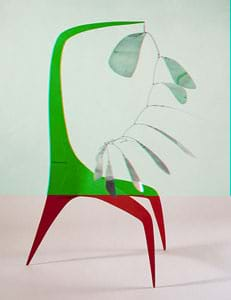
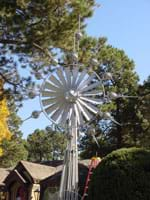
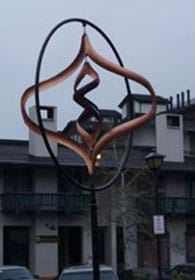
Today, many artists create amazing mobiles and kinetic sculptures that are moved by the forces of the wind (see Figures 2-4). Artists also must take other forces, such as gravity, into account as they design their works of art. Both engineers and artists must understand how different forces affect the things they create. Think about the list of forces we discussed earlier.
Procedure
Before the Activity
- Gather materials and make copies of the worksheets.
- Have the students complete the Mobile Math Worksheet for practice of balancing forces.
- Divide the class into teams of two students each.
With the Students
- Warm students up with a discussion question and some brainstorming. Ask students: What are forces? (Answer: A force is any push or pull on an object. Examples include gravity, wind, water.) Brainstorm with students on how forces affect our lives.
- Have the student teams use the paper, markers and scissors to design 6-10 cut-out figures to attach to the mobile. These can be varying shapes and sizes (see Activity Extensions section for an idea).
- While student teams are finishing, ask them some questions to keep them engaged: What is convection? (Answer: The movement of air currents.) Define a mobile? (Answer: A hanging or suspended structure that moves randomly when propelled by air currents.) What is one force we consider when balancing two weights (Answer: Gravity)
- Have the students prepare their paper figures by punching a hole into each and attaching a string (or needle and thread). Each figure should have a string for hanging it.
- Have students hang their figures from the ends of straws by tying the string from the figure to the straw.
- Have students attach the straws to one another until their mobile is balanced (see Figure 5). They may choose to cut the straws in half or leave as is. They should take into account the center of mass and downward forces while connecting the mobile. The students should feel free to create as many or as few layers as they wish.
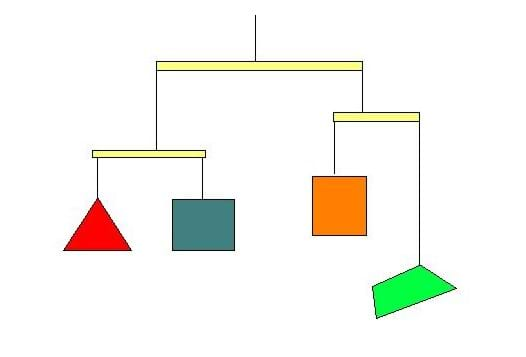
- Have each student team present their designs to the class.
- Have students complete the Giant Mobile Math Worksheet.
Vocabulary/Definitions
center of mass: The point at which all of an object's mass may be considered to be concentrated.
convective currents: Air movement caused by the rising of low-density hot air and the sinking of high-density cold air.
force: A push or a pull on an object.
gravity: A force that pushes objects towards the center of the Earth.
kinetic: Of, relating to, or produced by motion.
mobile: Artwork that moves with air currents.
Assessment
Pre-Activity Assessment
Brainstorming: As a class, have the students engage in open discussion. Remind students that in brainstorming, no idea or suggestion is "silly." All ideas should be respectfully heard. Take an uncritical position, encourage wild ideas and discourage criticism of ideas. Have them raise their hands to respond. List their ideas on the board. Ask the students:
- What are forces? (Answer: A force is any push or pull on an object. Examples include gravity, wind, water.)
- How do forces impact our lives?
Worksheet: Have students complete the Mobile Math Worksheet. Review their answers to gauge their comprehension of the subject.
Activity Embedded Assessment
Question/Answer: Ask the students questions to keep them engaged during the activity:
- What is convection? (Answer: The movement of air currents)
- Define a mobile? (Answer: A hanging or suspended structure that moves randomly when propelled by air currents.)
- What is one force we consider when balancing two weights? (Answer: Gravity)
- Why do engineers need to know about forces? (Answer: To build strong and safe structures, to know how their designs will work in the real-world when affected by wind, gravity, snow, people, etc.)
- Why do artists need to know about forces? (Answer: To build sculptures and mobiles that are balanced and safe when affected by forces such as wind, gravity, snow, people, etc.)
Post-Activity Assessment
Worksheet: Have students complete the Giant Mobile Math Worksheet. Review their answers to gauge their comprehension of the subject.
Discussion: Have students discuss arguments to support the claim that when the kinetic energy of an object changes, energy is transferred to or from the object.
Safety Issues
- Students should be careful handling scissors.
- If needle and thread is used, students should be careful when handling the needles.
Troubleshooting Tips
To save time, have students create fewer shapes.
As an easier alternative, follow the attached instructions for the Alternative Mobile Design, which instructs students to attach the cut-out shapes to a plate instead of straws.
Activity Extensions
Integrate students' concurrent study topics into this activity by specifying the subject matter for the cut-out paper shapes they create for their mobiles. For example, if students are studying the phases of the butterfly, have them create shapes that represent those phases, or if studying state history, have their shapes correspond to key events in state history.
Ask the students where else they might find forces in balance. For example, in the construction of buildings and bridges engineers want to make sure the forces (people, desks, cars, roofs, bathtubs full of water, snow, wind, etc.) can be supported by their design. They do this by adding up all the potential forces that could be applied to a structure and comparing that to the amount of force their design can withstand.
Activity Scaling
- For younger students (grades 3-4) who may have trouble balancing the straws, follow the attached Alternative Mobile Design. In this easier construction method, student attach their cut-out shapes to a plate instead of straws.
- For younger students (grades 3-4), simplify the multiplication and division problems on the Mobile Math Worksheet to include lower-level division.
Subscribe
Get the inside scoop on all things TeachEngineering such as new site features, curriculum updates, video releases, and more by signing up for our newsletter!More Curriculum Like This

Students learn how forces are used in the creation of art. As "paper engineers," students create their own mobiles and pop-up books, and identify and use the forces (air currents, gravity, hand movement) acting upon them.
References
Alexander Calder, Biography. The Collection, National Gallery of Art, Washington, DC. Accessed February 8, 2005. http://www.nga.gov/cgi-bin/pbio?55300
National Gallery of Art, Washington, DC. Accessed February 8, 2005. http://www.nga.gov/
On the Making of Mobiles by Alexander Calder. Calder Exhibition, National Gallery of Art, Washington, DC. Accessed February 8, 2005. http://www.nga.gov/exhibitions/calder/realsp/room8a-7.htm
Copyright
© 2005 by Regents of the University of Colorado.Contributors
Natalie Mach; Malinda Schaefer Zarske; Denise W. CarlsonSupporting Program
Integrated Teaching and Learning Program, College of Engineering, University of Colorado BoulderAcknowledgements
The contents of this digital library curriculum were developed under a grant from the Fund for the Improvement of Postsecondary Education (FIPSE), U.S. Department of Education and National Science Foundation GK-12 grant no. 0338326. However, these contents do not necessarily represent the policies of the Department of Education or National Science Foundation, and you should not assume endorsement by the federal government.
Last modified: February 24, 2020








User Comments & Tips